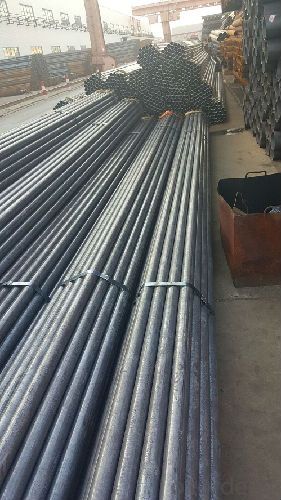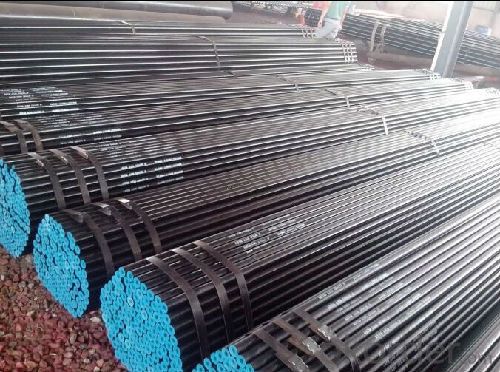Heat Exchanger Stainless Steel Pipe TP304 ASTM A213
- Loading Port:
- Ningbo
- Payment Terms:
- TT or LC
- Min Order Qty:
- 25 m.t.
- Supply Capability:
- 6000 m.t./month
OKorder Service Pledge
OKorder Financial Service
You Might Also Like
1、Structure of Heat Exchanger Stainless Steel Pipe TP304 ASTM A213
Heat Exchanger Stainless Steel Pipe TP304 ASTM A213 is formed by drawing a solid billet over a piercing rod to create the hollow shell. As the manufacturing process does not include any welding, Heat Exchanger Stainless Steel Pipe TP304 ASTM A213 are perceived to be stronger and more reliable. Historically Heat Exchanger Stainless Steel Pipe TP304 ASTM A213 was regarded as withstanding pressure better than other types, and was often more easily available than welded pipe.
2、Main Features of Heat Exchanger Stainless Steel Pipe TP304 ASTM A213
• High manufacturing accuracy
• High strength
• Small inertia resistance
• Strong heat dissipation ability
• Good visual effect
• Reasonable price
3、Heat Exchanger Stainless Steel Pipe TP304 ASTM A213 Specification:
Standard | GB, DIN, ASTM ASTM A106-2006, ASTM A53-2007 |
Grade | 10#-45#, 16Mn 10#, 20#, 45#, 16Mn |
Thickness | 8 - 33 mm |
Section Shape | Round |
Outer Diameter | 133 - 219 mm |
Place of Origin | Shandong, China (Mainland) |
Secondary Or Not | Non-secondary |
Application | Hydraulic Pipe |
Technique | Cold Drawn |
Certification | API |
Surface Treatment | factory state or painted black |
Special Pipe | API Pipe |
Alloy Or Not | Non-alloy |
Length | 5-12M |
Outer Diameter | 21.3-610mm |
Grade | 20#, 45#, Q345, API J55, API K55, API L80, API N80, API P110, A53B |
Standard | ASME, ASTM |
1) Material:20#(ASTM A 106/A53 GRB.API5LGRB,GB),45#,16Mn,10#.
2) Specification range:OD:21.3-610mm,WT:6-70mm,length:6-12m or according to the requirement of clients.
3) Excutive standards:GB,ASME API5L.ASTM A 106/A53,Despite of the above standards,we can also supply seamless steel pipe with standard of DIN,JIS,and so on,and also develop new products according to the requirements of our clients!
4) Surface:black lacquered,varnish coating or galvanized.
5) Ends:Beveled or square cut,plastic capped,painted.
6) Packing:bundles wrapped with strong steel strip,seaworthy packing.
4、Packaging & Delivery
Packaging Details: | seaworthy package,bundles wrapped with strong steel strip |
Delivery Detail: | 15-30days after received 30%TT |
5、FAQ of Heat Exchanger Stainless Steel Pipe TP304 ASTM A213
①How is the quality of your products?
Our products are manufactured strictly according to national and internaional standard, and we take a test
on every pipe before delivered out. If you want see our quality certifications and all kinds of testing report, please just ask us for it.
Guaranteed: If products’ quality don’t accord to discription as we give or the promise before you place order, we promise 100% refund.
②How about price?
Yes, we are factory and be able to give you lowest price below market one, and we have a policy that “ for saving time and absolutely honest business attitude, we quote as lowest as possible for any customer, and discount can be given according to quantity”,if you like bargain and factory price is not low enough as you think, just don’t waste your time.Please trust the quotation we would give you, it is professional one.
③Why should you chose us?
Chose happens because of quality, then price, We can give you both.Additionally, we can also offer professional products inquiry, products knowledge train(for agents), smooth goods delivery, exellent customer solution proposals.Our service formula: good quality+good price+good service=customer’s trust
SGS test is available, customer inspection before shipping is welcome, third party inspection is no problem.
6、Seamless Pipe ASTM A106/53 Images:


- Q:Can stainless steel pipes be used for oil and gas refineries?
- Yes, stainless steel pipes can be used for oil and gas refineries. Stainless steel is a highly durable and corrosion-resistant material, making it suitable for the harsh and corrosive environments found in refineries. It can withstand high pressures, extreme temperatures, and exposure to various chemicals and corrosive substances commonly found in oil and gas operations. Additionally, stainless steel pipes offer excellent resistance to erosion, pitting, and cracking, ensuring the integrity and longevity of the pipeline system.
- Q:What is the yield strength of stainless steel pipes?
- The yield strength of stainless steel pipes can vary depending on the specific grade of stainless steel used. However, most commonly used grades of stainless steel pipes have a yield strength ranging between 25,000 to 100,000 pounds per square inch (psi).
- Q:Can stainless steel pipes be used for petrochemical plants?
- Yes, stainless steel pipes can be used for petrochemical plants. Stainless steel is highly resistant to corrosion, making it an ideal choice for petrochemical plants where corrosive substances are handled. These pipes are capable of withstanding high temperatures and pressures, making them suitable for the harsh operating conditions of petrochemical plants. Additionally, stainless steel pipes have excellent mechanical properties, which ensure their durability and reliability in such industrial environments. Moreover, stainless steel pipes are easy to clean and maintain, reducing the risk of contamination and facilitating efficient operations in petrochemical plants.
- Q:Are stainless steel tubes and galvanized steel tubes the same?
- Galvanized steel pipe is common steel pipe, and then the surface coated with a layer of zinc coating, in order to prevent rust, as long as the surface layer is ground, it will rust.
- Q:Are stainless steel pipes suitable for wastewater pumping stations?
- Yes, stainless steel pipes are suitable for wastewater pumping stations. Stainless steel is highly resistant to corrosion, making it an ideal choice for handling wastewater which can be corrosive in nature. Additionally, stainless steel pipes are strong, durable, and have a long lifespan, making them suitable for the demanding conditions of wastewater pumping stations.
- Q:How do you calculate the expansion of stainless steel pipes?
- In order to calculate the expansion of stainless steel pipes, it is necessary to take into account the coefficient of thermal expansion (CTE) of the material. The CTE quantifies the extent to which a material expands or contracts when exposed to temperature changes. To begin, the initial length of the stainless steel pipe must be determined. This refers to the length of the pipe at the starting temperature. Subsequently, the final operating temperature of the pipe needs to be established. This denotes the temperature at which the expansion is desired to be calculated. The CTE value for the specific grade of stainless steel used in the pipe must be obtained. The CTE is typically expressed in units of per degree Celsius (or per degree Fahrenheit). Multiply the initial length of the pipe by the CTE value and then multiply it by the change in temperature. This computation yields the expansion or contraction of the pipe within the given temperature range. For instance, assume a stainless steel pipe with an initial length of 10 meters, a CTE of 17 x 10^-6 per degree Celsius, and a desired expansion calculation at a final temperature of 100 degrees Celsius. The change in temperature is determined by subtracting the initial temperature from the final temperature. Expansion = Initial Length * CTE * Change in Temperature Expansion = 10 meters * 17 x 10^-6 per degree Celsius * 100 degrees Celsius Expansion = 0.0017 meters or 1.7 millimeters Consequently, when subjected to a temperature increase of 100 degrees Celsius, the stainless steel pipe would expand by 1.7 millimeters. It is important to note that this calculation assumes a uniform expansion throughout the entire length of the pipe. In reality, thermal expansion may vary due to factors such as pipe diameter, wall thickness, and other structural considerations. Thus, it is advisable to consult industry standards or engineering references for more precise calculations in specific applications.
- Q:How do you prevent erosion in stainless steel pipes?
- One way to prevent erosion in stainless steel pipes is by applying protective coatings or linings to the interior surface of the pipes. These coatings act as a barrier, preventing direct contact between the corrosive fluids or materials and the stainless steel, thereby reducing the risk of erosion.
- Q:Can stainless steel pipes be used for wastewater treatment systems?
- Indeed, wastewater treatment systems can make use of stainless steel pipes. Stainless steel, being an exceptionally durable and corrosion-resistant substance, proves to be an excellent selection for pipes situated in challenging surroundings like wastewater treatment facilities. These pipes are capable of enduring the corrosive attributes of wastewater, encompassing chemicals and varying pH levels. Furthermore, stainless steel pipes possess a sleek surface, which aids in reducing the buildup of waste and bacteria, thereby guaranteeing the smooth movement of wastewater within the system. Moreover, stainless steel can be effortlessly cleaned and maintained, making it a cost-efficient and trustworthy alternative for wastewater treatment systems.
- Q:Can stainless steel pipes be used for wastewater systems?
- Certainly! Stainless steel pipes are capable of being used in wastewater systems. Due to its high durability and resistance to corrosion, stainless steel is an appropriate material for various applications, including wastewater systems. The robust nature of stainless steel pipes enables them to withstand the harsh and corrosive properties of wastewater, preventing any potential leaks, cracks, or damages that could compromise the system's integrity. Furthermore, stainless steel pipes are easily cleanable, ensuring that hygiene standards are maintained within wastewater systems. Their long-lasting properties and resistance to rust also make them a cost-effective choice in the long term, as they necessitate less maintenance and replacement when compared to alternative materials. Overall, stainless steel pipes provide a dependable option for wastewater systems, guaranteeing efficient and secure wastewater disposal.
- Q:What is the difference between 304H and 304L stainless steel pipes?
- The carbon content is the main distinction between 304H and 304L stainless steel pipes. 304H pipes contain a higher carbon content, typically ranging from 0.04-0.10%, making them ideal for high-temperature uses. This increased carbon content enhances their strength and resistance to sensitization, which is the creation of chromium carbides at grain boundaries, resulting in reduced corrosion resistance. On the flip side, 304L stainless steel pipes possess a lower carbon content, usually around 0.03%, making them more appropriate for welding purposes. The reduced carbon content helps minimize the formation of chromium carbides, thereby lowering the risk of sensitization during welding. As a result, corrosion resistance is improved, and weldability is enhanced. To summarize, albeit both 304H and 304L stainless steel pipes are variations of the 304 grade, their distinction lies in their carbon content. 304H pipes are favored for high-temperature applications due to their higher carbon content and improved high-temperature strength, while 304L pipes are better suited for welding applications due to their lower carbon content and enhanced weldability.
1. Manufacturer Overview |
|
|---|---|
| Location | |
| Year Established | |
| Annual Output Value | |
| Main Markets | |
| Company Certifications | |
2. Manufacturer Certificates |
|
|---|---|
| a) Certification Name | |
| Range | |
| Reference | |
| Validity Period | |
3. Manufacturer Capability |
|
|---|---|
| a)Trade Capacity | |
| Nearest Port | |
| Export Percentage | |
| No.of Employees in Trade Department | |
| Language Spoken: | |
| b)Factory Information | |
| Factory Size: | |
| No. of Production Lines | |
| Contract Manufacturing | |
| Product Price Range | |
Send your message to us
Heat Exchanger Stainless Steel Pipe TP304 ASTM A213
- Loading Port:
- Ningbo
- Payment Terms:
- TT or LC
- Min Order Qty:
- 25 m.t.
- Supply Capability:
- 6000 m.t./month
OKorder Service Pledge
OKorder Financial Service
Similar products
New products
Hot products
Hot Searches
Related keywords






























